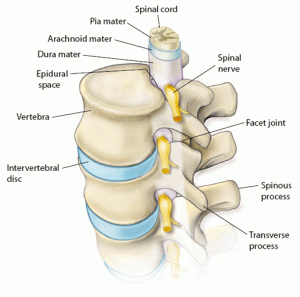
Headaches are as common as they are disabling. There are many different sources of headache pain, including amoung other things, sinus and migraine. However, headaches eminating from the neck, or cervicogenic headaches, are a particular type of headache. Good news- these are highly treatable.
A cervicogenic headache is a headache which originates from the cervical spine usually the upper cervical joints.
The cervical spine (the neck) comprises of 7 vertebrae, each vertebrae connect with the vertebrae above and below via facet joints. The facet joints are on either side of the vertebrae and the disc lies in between the vertebrae.
vertebrae and the disc lies in between the vertebrae.
With every movement, and with sustained postures we apply compression or stretch forces through our facet joints (those little tiny joints you can see in the image),
muscles, ligaments and nerves of the neck. These postures can stress these structure beyond their limits. Injury to these structures may occur traumatically either with an accident or an injury, or gradually over time due to repetitive or prolonged activities such as prolong slouching and poor postures, working at a computer with a poor ergonomic set-up or activities using the arms in front of the body. When this occurs pain may be referred into the head causing a headache. This condition is known as a cervicogenic headache.
Cervicogenic headaches typically occur due to problems with the soft tissue structures of the top 3 cervical vertebrae (C1, C2 and C3). The nerve that supply the upper neck also supply the skin overlying the head, forehead, jaw line, back of the eyes and ears. As a result pain arising from structures of the upper neck may refer to any of these regions causing a cervicogenic headache.
There are several contributing factors that can predispose you to cervicogenic headaches.
One of our physiotherapists will conduct a thorough subjective and objective examination which will allow them to can accurately diagnose a cervicogenic headache. Occasionally, investigations such as an X-Ray, MRI or CT may be required to assist diagnosis.
Physiotherapy treatment for patients with this condition is vital to hasten the healing process, ensure an optimal outcome and decrease the likelihood of injury recurrence. Treatment may comprise:
Most patients with this condition heal quickly and have a full recovery with appropriate physiotherapy treatment. Recovery time varies from patient to patient depending on compliance with treatment and severity of injury. With ideal treatment, patients with minor cases of cervicogenic headache may be pain free in as little as a couple of days, usually It takes 2-3 weeks and in severe and or chronic cases a full recovery can take a few months.
Jude Holroyd is the Principal Physiotherapist at The Healthy Body Company in Jordan Springs. You might be interested in other articles written by Jude including: